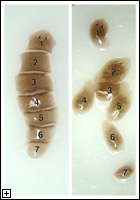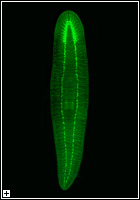





      |

 Although
all animals possess some ability to regenerate, that capacity varies widely
from species to species. The planarian flatworm, a relatively simple organism,
exhibits remarkable regenerative ability attributable to a population
of pluripotent stem cells capable of giving rise to all cell types in
the body. Study of planarian regeneration may enable us to better understand
how we rebuild tissues and organs damaged by injury, disease or as part
of the natural aging process. The ultimate goals of our laboratory are
to understand the mechanisms regulating the planarian stem cell system
and to determine what signals are involved in both maintaining these cells'
totipotency and in activating them during regeneration.
Although
all animals possess some ability to regenerate, that capacity varies widely
from species to species. The planarian flatworm, a relatively simple organism,
exhibits remarkable regenerative ability attributable to a population
of pluripotent stem cells capable of giving rise to all cell types in
the body. Study of planarian regeneration may enable us to better understand
how we rebuild tissues and organs damaged by injury, disease or as part
of the natural aging process. The ultimate goals of our laboratory are
to understand the mechanisms regulating the planarian stem cell system
and to determine what signals are involved in both maintaining these cells'
totipotency and in activating them during regeneration.
In recent years, planarian research has benefited from the application of molecular techniques such as whole-mount in situ hybridization and gene-knockdown by RNA interference. One of our laboratory's recent successes has been the identification of the nou-darake gene, a key element in modulating FGF signaling in stem cells to restrict brain tissue to the head region of planarians. These findings may provide valuable insights into the field of regenerative medicine, especially neural regeneration.
 The
study of planarians may also help to reveal how higher organisms develop
complex cell systems, such as the nervous system, during evolution. A
bilaterally symmetric animal, the planarian is believed to be the simplest
extant taxon to form a distinct head. Although the planarian brain is
very simple, it is capable of regulating behaviors in response to a variety
of environmental signals. The establishment of EST databases for a variety
of species, including the planarian and the fresh water sponge (one of
the most primitive forms of multicellular life), promises to provide invaluable
resources for the study of evolutionary biology and a basis for comparative
analyses of the genomics underlying the shared and distinct features of
these organisms.
The
study of planarians may also help to reveal how higher organisms develop
complex cell systems, such as the nervous system, during evolution. A
bilaterally symmetric animal, the planarian is believed to be the simplest
extant taxon to form a distinct head. Although the planarian brain is
very simple, it is capable of regulating behaviors in response to a variety
of environmental signals. The establishment of EST databases for a variety
of species, including the planarian and the fresh water sponge (one of
the most primitive forms of multicellular life), promises to provide invaluable
resources for the study of evolutionary biology and a basis for comparative
analyses of the genomics underlying the shared and distinct features of
these organisms.
By focusing on the development of the flatworm brain, we hope to use it as a model to shed light on the contribution of stem cells to the development of increasingly complex cellular systems through evolution, studies which we hope will also help to improve our understanding the role of the stem cell system in evolutionary regeneration biology.